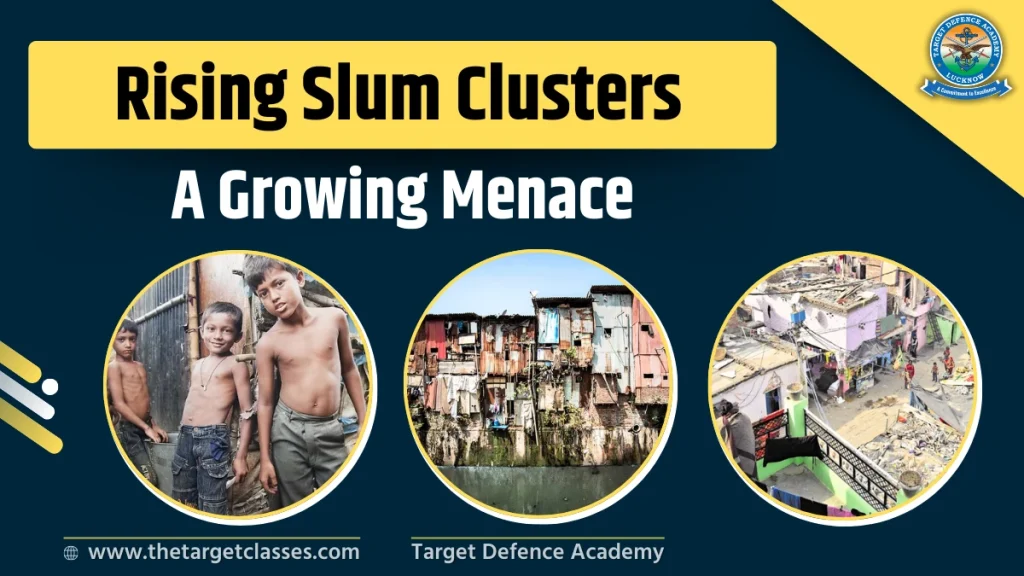Why in the news?
According to a 2024 study, over 158 million people live in slums located in floodplains in South Asia, with India having the maximum share. Also, around 40% of slum dwellers in India reside in urban and suburban areas. Here, we have given a detailed overview of Rising Slum Clusters.
Growth of Slums
(a) Slums are densely populated urban areas characterised by poor-quality housing, the lack of adequate living space, public services, and accommodating large numbers of informal residents with insecure tenure.
(b) According to UN-Habitat (2021), slum dwellers across the globe have increased from 980 million in 2010 to 1,059 million in 2020, accounting for 24.2% of the world’s urban population.
(c) India’s slum population in 2020 is estimated at 236 million, suggesting that nearly half of its urban population lives in slums (UN-Habitat 2021).

Factors giving rise to Slums
(i) Rapid Urbanisation: Massive rural-to-urban migration for livelihood and better opportunities leads to unplanned settlements.
(ii) Lack of Affordable Housing: Insufficient low-cost housing forces poor migrants to settle in informal slums.
(iii) Poverty and Unemployment: Economic insecurity prevents access to formal housing markets.
(iv) Land Scarcity and High Land Prices: Urban land shortages and expensive prices restrict housing availability for the poor.
(v) Inadequate Urban Planning and Governance: Poor infrastructure, lack of formal tenure, and weak municipal services drive informal settlements.
(vi) Social Exclusion: Marginalised groups face discrimination, limiting their access to decent housing.
(vi) Environmental Factors: Slums often develop in hazard-prone areas like floodplains (e.g., Ganga delta) due to low-cost land availability.
Impacts and Concerns of Rising Slum Clusters
(i) Health and Sanitation Risks: Overcrowding, poor sanitation, and lack of clean water cause public health issues.
(ii) Vulnerability to Disasters: Slums are disproportionately affected by floods, heatwaves, and other climate-related disasters.
(iii) Social Challenges: Slum dwellers face insecure tenure, social stigma, poor education, and limited access to services.
(iv) Environmental Degradation: Waste accumulation and lack of green space degrade urban environments.
(v) Economic Impact: Public-Private Partnerships models for slum rehabilitation have failed to attract developers due to low commercial viability and regulatory hurdles.
Urban Flooding: Rising Issue of Cities
Overnutrition: India’s New Urban Challenge
Download the Mobile App of Target Defence Academy
Best NDA Coaching in Lucknow | Top Defence Coaching in Lucknow
Way Ahead
(i) Holistic Slum Rehabilitation: Integrate housing, infrastructure, livelihood, and social services with community engagement.
(ii) Legal and Institutional Clarity: Streamline land rights, tenure security, and use clear frameworks for slum upgrading.
(iii) Innovative Financing: Utilise Public-Private Partnerships (PPP), Transferable Development Rights (TDR), and micro-financing to fund redevelopment.
(iv) Inclusive Urban Planning: Adapt local models respecting the socio-cultural and economic diversity of slum communities.
(v) Decentralised Infrastructure: Cost-effective sanitation, water, as well as energy decentralised systems tailored for slum areas.
(vi) Community Participation: Engage slum residents in planning as well as implementation to ensure acceptance and cultural appropriateness.
Conclusion
The problem is very complex and multifaceted, demanding a holistic roadmap to tackle the several difficulties witnessed by residents of these areas. So, Initiatives for better living standards, cost-effective housing, and better economic prospects are essential in making significant progress in navigating the torturous path of slum dwellers. Focused and cooperative approaches will ensure the attainment of the objective of establishing sustainable and inclusive urban settings. We hope the above information on Rising Slum Clusters will help you boost your knowledge.

